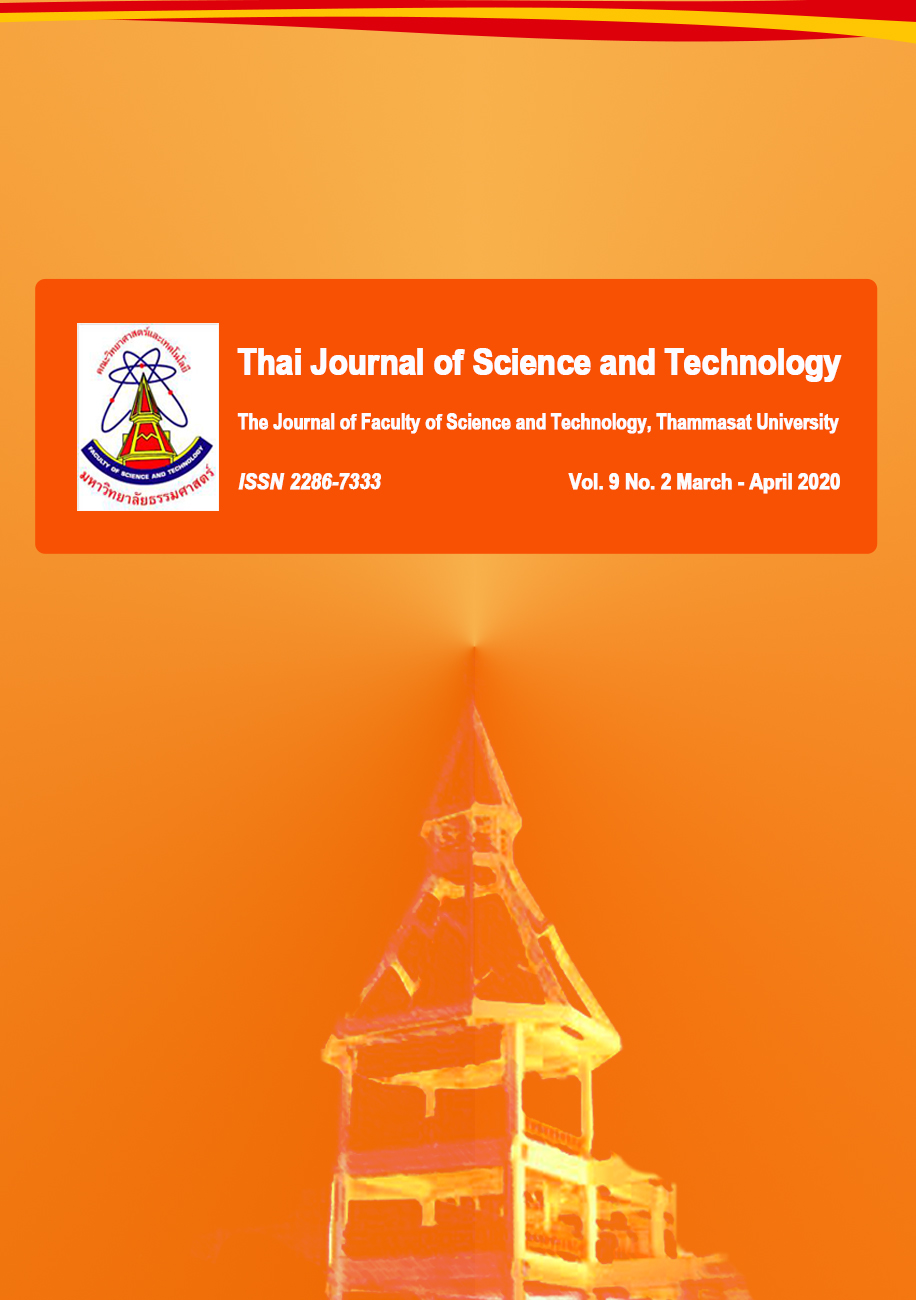ปริมาณฟีนอลิกและฤทธิ์การต้านอนุมูลอิสระในชาใบหม่อนและชาผงใบหม่อนชนิดละลายน้ำ
Main Article Content
Abstract
Phenolic contents and antioxidant activities from the different mulberry leaves, i.e. fresh mulberry leaves, dried mulberry leaves, and dried mulberry leaves after being immersed in boiling water were studied. Mulberry leaf samples were refluxed with three different solvents, i.e. water, water: ethanol (1:1 v/v), and ethanol for 90 minutes. Total phenolic contents of different mulberry leaf extracts were assessed based on the Folin-Ciocalteu method. Antioxidant activity was investigated by DPPH assay. Chlorogenic acid, the most significant antioxidant phenolic acid found in mulberry leaves was determined by high performance liquid chromatography. The results showed that fresh mulberry leaves extracted with water provided the highest phenolic content (21.89 mgGAE/g DW) and antioxidant activity (45.80 %). Fresh mulberry leaf extracts admixed with maltodextrin were prepared into water soluble tea powder. The effects of two different drying processes, i.e. freeze drying and spray drying on the phenolic contents and the antioxidant activities were investigated. The phenolic contents of mulberry tea powder obtained from freeze drying and spray drying were 4.19 and 4.44 mgGAE/g sample, respectively. The antioxidant activities of the freeze drying and spray drying tea powder were 75.95 and 77.91 %, respectively. They were not significantly different. Chlorogenic acid, the main phenolic acid was also found in mulberry leaf tea powder.
Article Details
บทความที่ได้รับการตีพิมพ์เป็นลิขสิทธิ์ของคณะวิทยาศาสตร์และเทคโนโลยี มหาวิทยาลัยธรรมศาสตร์ ข้อความที่ปรากฏในแต่ละเรื่องของวารสารเล่มนี้เป็นเพียงความเห็นส่วนตัวของผู้เขียน ไม่มีความเกี่ยวข้องกับคณะวิทยาศาสตร์และเทคโนโลยี หรือคณาจารย์ท่านอื่นในมหาวิทยาลัยธรรมศาสตร์ ผู้เขียนต้องยืนยันว่าความรับผิดชอบต่อทุกข้อความที่นำเสนอไว้ในบทความของตน หากมีข้อผิดพลาดหรือความไม่ถูกต้องใด ๆ
References
Banchobphutsa, Y., 2012, The efficacy of Mous alba leaf tea in patients with dyslipidemia, In Proceeding of the 6th Mae Fah Luang Annual Research Conference in Dermatology and Aesthetic Dermatology, Mae Fah Luang University, Chiang Rai.
Booranasuksakul, U., Rueangsri, N., Prasertsri, P. and Singhato, A., 2019, Effects of mulberry (Morus alba) leaf tea on blood glucose and satiety in healthy subjects, Srinagarind Med. J. 34: 237-242.
Buchner, N., Krumbein, A., Rohn, S. and Kroh, L.W., 2006, Effect of thermal processing on the flavonols rutin and quercetin, Rapid Commun. Mass Spectrom. 20: 3229-3235.
Deetae, P., Parichanon, P., Trakunleewatthana, P., Chanseetis, C. and Lertsiri, S., 2012, Antioxidant and anti-glycation properties of Thai herbal teas in comparison with conventional teas, Food Chem. 133: 953-959.
Gong, Y., Liu, X., He, W.H., Xu, H.G., Yuan, F. and Gao, Y.X., 2012, Investigation into the antioxidant activity and chemical composition of alcoholic extracts from defatted marigold (Tagetes erecta L.) residue, Fitoterapia 83: 481-489.
Hunyadi, A., Martins, A., Hsieh, T.J., Seres, A. and Zupko, I., 2012, Chlorogenic acid and rutin play a major role in the in vivo anti-diabetic activity of Morus alba leaf extract on type II diabetic rats, PLoS ONE 7: 1-6.
Jongroysub, B., Harnnurak, A., Rakpong, N., Phuwang, M., Teerakul, S. and Riebroy, S., 2016, Effect of Packaging and Storage Times on Antioxidant Activity and Blood Sugar Level Reduction Properties of Mulberry Leave Tea Herb, The Queen Sirikit Department of Sericulture, Ministry of Agriculture and Cooperatives, Bangkok.
Kalinova, J.P., Vrchotova, N. and Triska, J., 2018, Contribution to the study of rutin stability in the achenes of Tartary buckwheat (Fagopyrum tataricum), Food Chem. 258: 314-320.
Katsube, T., Tsurunaga, Y., Sugiyama, M., Furuno,
T. and Yamasaki, Y., 2009, Effect of air-drying temperature on antioxidant capacity and stability of polyphenolic compounds in mulberry (Morus alba L.) leaves, Food Chem. 113: 964-969.
Nayak, B., Liu, R.H. and Tang, J.M., 2015, Effect of processing on phenolic antioxidants of fruits, vegetables, and grains: A review, Crit. Rev. Food Sci. Nutr. 55: 887-918.
Park, E., Lee, S.M., Lee, J. and Kim, J.H., 2013, Anti-inflammatory activity of mulberry leaf extract through inhibition of NF-κB, J. Funct. Foods 5: 178-186.
Sánchez-Salcedo, E.M., Mena, P., García-Viguera, C., Hernández, F. and Martínez, J.J., 2015, (Poly)phenolic compounds and antioxidant activity of white (Morus alba) and black (Morus nigra) mulberry leaves: Their potential for new products rich in phytochemicals, J. Funct. Foods 18: 1039-1046.
Sribuarod, K., 2009, Research and Development on Food and Beverage Production from Mulberry Project, The Queen Sirikit Department of Sericulture, Bangkok.
Tian, S., Tang, M. and Zhao, B., 2016, Current anti-diabetes mechanisms and clinical trials using Morus alba L., J. Tradit. Chin. Med. Sci. 3: 3-8.
Wen, P., Hu, T.G., Linhardt, R.J., Liao, S.T., Wu, H. and Zou, Y.X., 2019, Mulberry: A review of bioactive compounds and advanced processing technology, Trends Food Sci. Technol. 83: 138-158.


